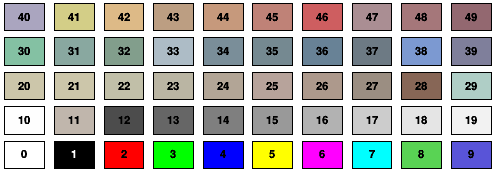class TAttText
Text Attributes class
Text attributes
Text attributes are:Text Alignment
The text alignment is an integer number (align) allowing to control the horizontal and vertical position of the text string with respect to the text position. The text alignment of any class inheriting from TAttText can be changed using the method SetTextAlign and retrieved using the method GetTextAlign.align = 10*HorizontalAlign + VerticalAlignFor horizontal alignment the following convention applies:
1=left adjusted, 2=centered, 3=right adjustedFor vertical alignment the following convention applies:
1=bottom adjusted, 2=centered, 3=top adjustedFor example:
align = 11 = left adjusted and bottom adjusted align = 32 = right adjusted and vertically centered
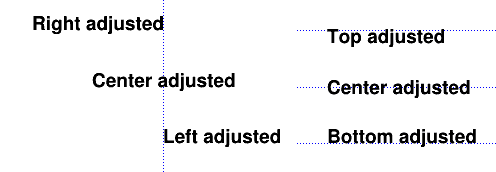
{
TCanvas *Ta = new TCanvas("Ta","Ta",0,0,500,200);
Ta->Range(0,0,1,1);
TLine *lv = new TLine;
lv->SetLineStyle(3); lv->SetLineColor(kBlue);
lv->DrawLine(0.33,0.0,0.33,1.0);
lv->DrawLine(0.6,0.165,1.,0.165);
lv->DrawLine(0.6,0.493,1.,0.493);
lv->DrawLine(0.6,0.823,1.,0.823);
// Horizontal alignment.
TText *th1 = new TText(0.33,0.165,"Left adjusted");
th1->SetTextAlign(11); th1->SetTextSize(0.12);
th1->Draw();
TText *th2 = new TText(0.33,0.493,"Center adjusted");
th2->SetTextAlign(21); th2->SetTextSize(0.12);
th2->Draw();
TText *th3 = new TText(0.33,0.823,"Right adjusted");
th3->SetTextAlign(31); th3->SetTextSize(0.12);
th3->Draw();
// Vertical alignment.
TText *tv1 = new TText(0.66,0.165,"Bottom adjusted");
tv1->SetTextAlign(11); tv1->SetTextSize(0.12);
tv1->Draw();
TText *tv2 = new TText(0.66,0.493,"Center adjusted");
tv2->SetTextAlign(12); tv2->SetTextSize(0.12);
tv2->Draw();
TText *tv3 = new TText(0.66,0.823,"Top adjusted");
tv3->SetTextAlign(13); tv3->SetTextSize(0.12);
tv3->Draw();
return Ta;
}Text Angle
Text angle in degrees. The text angle of any class inheriting from TAttText can be changed using the method SetTextAngle and retrieved using the method GetTextAngle. The following picture shows the text angle: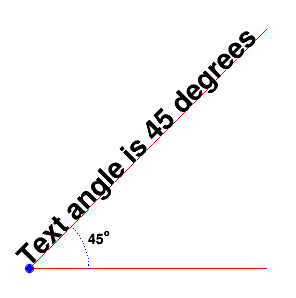
{
TCanvas *Ta = new TCanvas("Ta","Text angle",0,0,300,326);
Ta->Range(0,0,1,1);
TLine *l = new TLine();
l->SetLineColor(kRed);
l->DrawLine(0.1,0.1,0.9,0.1);
l->DrawLine(0.1,0.1,0.9,0.9);
TMarker *m = new TMarker();
m->SetMarkerStyle(20);
m->SetMarkerColor(kBlue);
m->DrawMarker(0.1,0.1);
TArc *a = new TArc();
a->SetFillStyle(0);
a->SetLineColor(kBlue); a->SetLineStyle(3);
a->DrawArc(0.1, 0.1, 0.2, 0.,45.,"only");
TText *tt = new TText(0.1,0.1,"Text angle is 45 degrees");
tt->SetTextAlign(11); tt->SetTextSize(0.1);
tt->SetTextAngle(45);
tt->Draw();
TLatex *t1 = new TLatex(0.3,0.18,"45^{o}");
t1->Draw();
return Ta;
}Mnemonic constants are available: <pre> kHAlignLeft = 10, kHAlignCenter = 20, kHAlignRight = 30, kVAlignBottom = 1, kVAlignCenter = 2, kVAlignTop = 3 </pre> They allow to write: <pre> object->SetTextAlign(kHAlignLeft+kVAlignTop); </pre>
Text Color
The text color is a color index (integer) pointing in the ROOT color table. The text color of any class inheriting from TAttText can be changed using the method SetTextColor and retrieved using the method GetTextColor. The following table shows the first 50 default colors.Color transparency
SetTextColorAlpha(), allows to set a transparent color. In the following example the text color of the text text is set to blue with a transparency of 35%. The color kBlue itself remains fully opaque.
text->SetTextColorAlpha(kBlue, 0.35);
The transparency is available on all platforms when the flagOpenGL.CanvasPreferGL is set to 1 in $ROOTSYS/etc/system.rootrc, or on Mac with the Cocoa backend. On the file output it is visible with PDF, PNG, Gif, JPEG, SVG ... but not PostScript.
Text Size
If the text precision (see next paragraph) is smaller than 3, the text size (textsize) is a fraction of the current pad size. Therefore the same textsize value can generate text outputs with different absolute sizes in two different pads. The text size in pixels (charheight) is computed the following way:
pad_width = gPad->XtoPixel(gPad->GetX2()); pad_height = gPad->YtoPixel(gPad->GetY1()); if (pad_width < pad_height) charheight = textsize*pad_width; else charheight = textsize*pad_height;
If the text precision is equal to 3, the text size doesn't depend on the pad's dimensions. A given textsize value always generates the same absolute size. The text size (charheight) is given in pixels:
charheight = textsize;
Note that to scale fonts to the same size as the old True Type package a scale factor of 0.93376068 is apply to the text size before drawing.
The text size of any class inheriting from TAttText can be changed using the method SetTextSize and retrieved using the method GetTextSize.
Text Font and Precision
The text font code is combination of the font number and the precision.Text font code = 10*fontnumber + precisionFont numbers must be between 1 and 14.
The precision can be:
precision = 0 fast hardware fonts (steps in the size)
precision = 1 scalable and rotatable hardware fonts (see below)
precision = 2 scalable and rotatable hardware fonts
precision = 3 scalable and rotatable hardware fonts. Text size
is given in pixels.
The text font and precision of any class inheriting from TAttText can be changed using the method SetTextFont and retrieved using the method GetTextFont.
Font quality and speed
When precision 0 is used, only the original non-scaled system fonts are used. The fonts have a minimum (4) and maximum (37) size in pixels. These fonts are fast and are of good quality. Their size varies with large steps and they cannot be rotated. Precision 1 and 2 fonts have a different behaviour depending if the True Type Fonts (TTF) are used or not. If TTF are used, you always get very good quality scalable and rotatable fonts. However TTF are slow.How to use True Type Fonts
One can activate the TTF by adding (or activating) the following line in the .rootrc file:Unix.*.Root.UseTTFonts: trueIt is possible to check the TTF are in use in a Root session with the command:
gEnv->Print();If the TTF are in use the following line will appear at the beginning of the printout given by this command:
Unix.*.Root.UseTTFonts: true [Global]
List of the currently supported fonts
Font number X11 Names Win32/TTF Names
1 : times-medium-i-normal "Times New Roman"
2 : times-bold-r-normal "Times New Roman"
3 : times-bold-i-normal "Times New Roman"
4 : helvetica-medium-r-normal "Arial"
5 : helvetica-medium-o-normal "Arial"
6 : helvetica-bold-r-normal "Arial"
7 : helvetica-bold-o-normal "Arial"
8 : courier-medium-r-normal "Courier New"
9 : courier-medium-o-normal "Courier New"
10 : courier-bold-r-normal "Courier New"
11 : courier-bold-o-normal "Courier New"
12 : symbol-medium-r-normal "Symbol"
13 : times-medium-r-normal "Times New Roman"
14 : "Wingdings"
15 : Symbol italic (derived from Symbol)
The following picture shows how each font looks. The number on the left is the "text font code". In this picture precision 2 was selected.
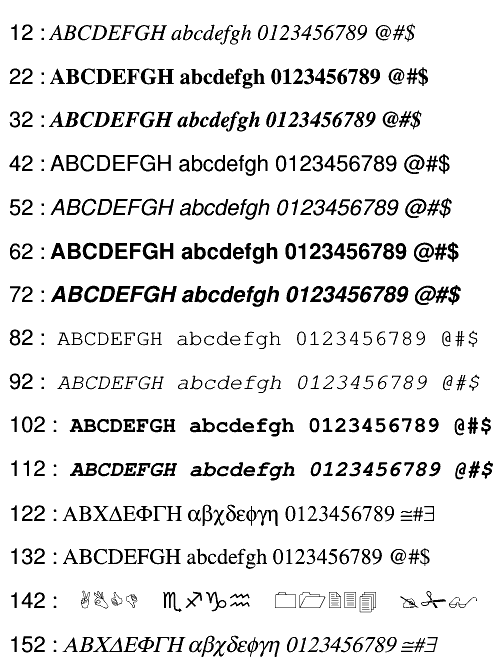
void drawtext(double x, double y, int f, const char *s) { TLatex *t = new TLatex(x,y,Form("#font[41]{%d :} %s",f,s)); t->SetTextFont(f); t->SetTextAlign(12); t->SetTextSize(0.048); t->Draw(); } TCanvas * fonts() { TCanvas *Tf = new TCanvas("Tf", "Tf",0,0,500,700); Tf->Range(0,0,1,1); Tf->SetBorderSize(2); Tf->SetFrameFillColor(0); double y = 0.95; for (int f = 12; f<=152; f+=10) { if (f!=142) drawtext(0.02,y, f,"ABCDEFGH abcdefgh 0123456789 @#$"); else drawtext(0.02,y, f,"ABCD efgh 01234 @#$"); y -= 0.065; } return Tf; }
Function Members (Methods)
| virtual | ~TAttText() |
| static TClass* | Class() |
| void | Copy(TAttText& atttext) const |
| virtual Short_t | GetTextAlign() const |
| virtual Float_t | GetTextAngle() const |
| virtual Color_t | GetTextColor() const |
| virtual Font_t | GetTextFont() const |
| virtual Float_t | GetTextSize() const |
| virtual TClass* | IsA() const |
| virtual void | Modify() |
| TAttText& | operator=(const TAttText&) |
| virtual void | ResetAttText(Option_t* toption = "") |
| virtual void | SaveTextAttributes(ostream& out, const char* name, Int_t alidef = 12, Float_t angdef = 0, Int_t coldef = 1, Int_t fondef = 61, Float_t sizdef = 1) |
| virtual void | SetTextAlign(Short_t align = 11) |
| virtual void | SetTextAngle(Float_t tangle = 0)MENU |
| virtual void | SetTextAttributes()MENU |
| virtual void | SetTextColor(Color_t tcolor = 1) |
| virtual void | SetTextColorAlpha(Color_t tcolor, Float_t talpha) |
| virtual void | SetTextFont(Font_t tfont = 62) |
| virtual void | SetTextSize(Float_t tsize = 1) |
| virtual void | SetTextSizePixels(Int_t npixels) |
| virtual void | ShowMembers(TMemberInspector& insp) const |
| virtual void | Streamer(TBuffer&) |
| void | StreamerNVirtual(TBuffer& ClassDef_StreamerNVirtual_b) |
| TAttText() | |
| TAttText(const TAttText&) | |
| TAttText(Int_t align, Float_t angle, Color_t color, Style_t font, Float_t tsize) |
Class Charts
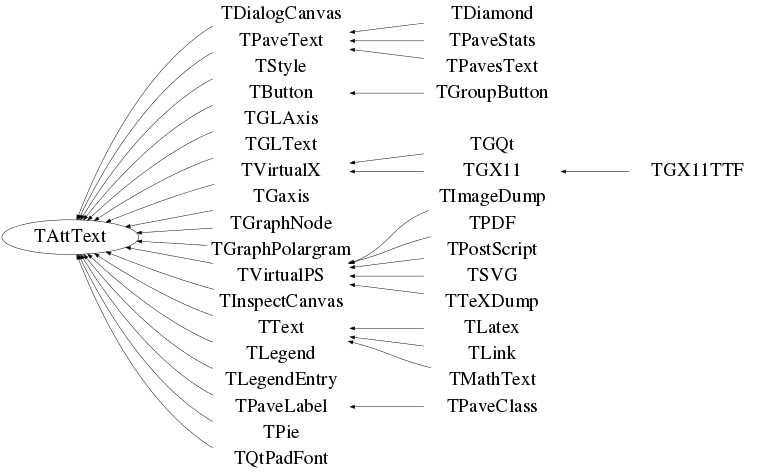
Function documentation
AttText normal constructor. Text attributes are taken from the argument list.
Save text attributes as C++ statement(s) on output stream out.
Set a transparent marker color. talpha defines the percentage of the color opacity from 0. (fully transparent) to 1. (fully opaque).
Set the text size in pixels. If the font precision is greater than 2, the text size is set to npixels, otherwise the text size is computed as a percent of the pad size.
